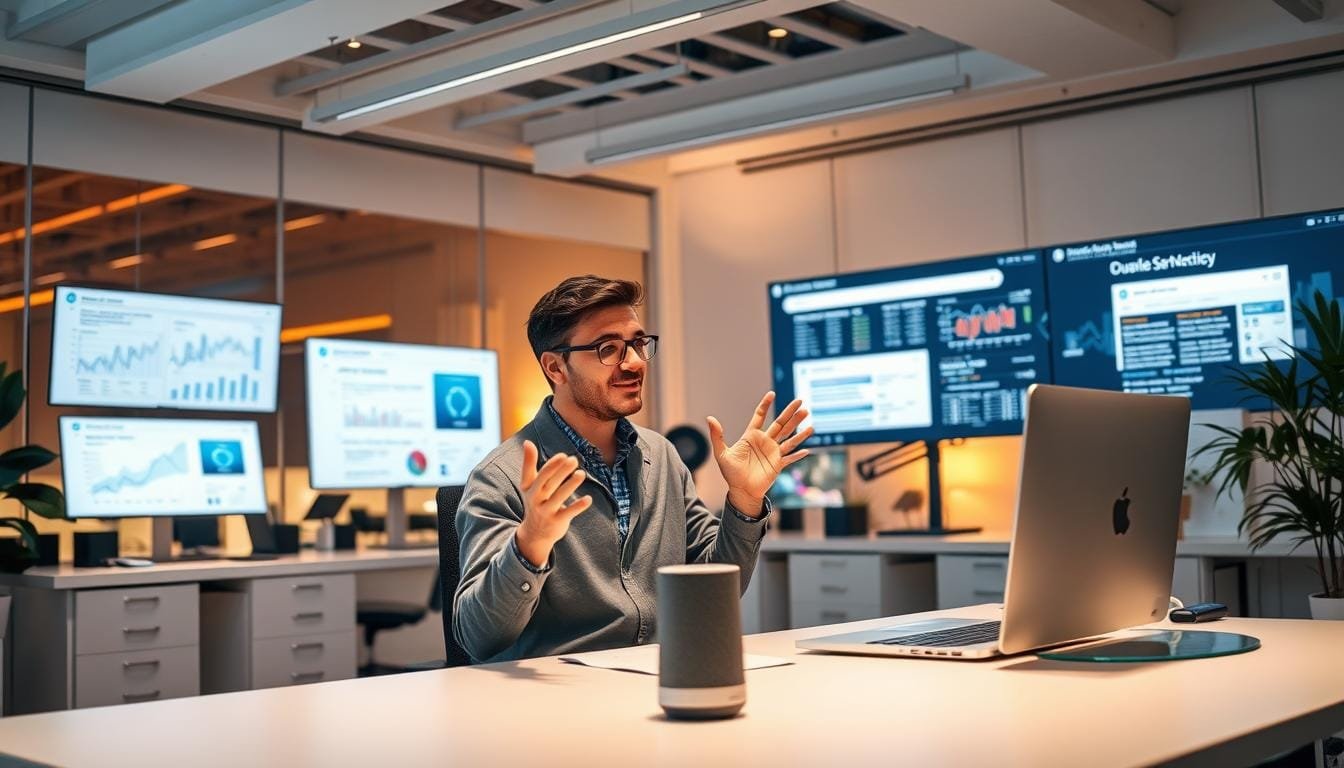What if your business becomes invisible to 60% of consumers by 2025? With nearly three in five adults aged 25-34 already using voice-activated queries daily, companies ignoring this shift risk fading into obscurity. The way people seek information has transformed – and traditional SEO tactics simply won’t cut it.
Research reveals the voice assistant market will surpass 20 million users by 2028. In India, where smartphone adoption grows rapidly, this trend reshapes how brands connect with audiences. Unlike typed searches, voice interactions use natural language – think “Where’s the nearest chai shop?” rather than “best tea near me”.
Businesses adapting now gain a critical edge. Tailoring content for platforms like Google and Alexa requires understanding their unique algorithms. For instance, Alexa users often seek instant answers, while Google queries lean towards localised results. Both demand conversational phrasing and long-tail keywords.
Mastering these nuances isn’t optional. As highlighted in our guide to the advantages and challenges of SEO, staying relevant means evolving with technology. Ready to future-proof your digital presence? Let’s explore the strategies that’ll keep you audible in 2025’s voice-first landscape.
Understanding Voice Search Optimisation

The way people interact with technology is shifting from typing to speaking. Over 40% of Indian consumers now prefer asking devices questions aloud rather than typing them. This behavioural change demands a new approach to how businesses structure their online content.
Defining the Concept and Its Importance
Voice search optimisation focuses on tailoring digital content for spoken queries. Unlike traditional methods, it prioritises natural language patterns and complete questions like “Where can I buy organic spices nearby?”. Platforms like Google Assistant and Alexa favour direct, conversational responses that match how people actually speak.
Benefits in the Digital Marketing Landscape
Adopting this strategy offers three key advantages for Indian businesses:
- Stronger local visibility for “near me” searches
- Higher engagement through instant, voice-delivered answers
- Competitive edge in markets where smartphone usage grows 22% annually
Companies integrating these principles, like those using targeted webinar strategies, often see faster connection with mobile-first audiences. It’s not just about ranking higher – it’s about becoming the most helpful voice in the room.
The Growing Influence of Voice-Activated Devices

India’s digital landscape is undergoing a silent revolution, powered by voice commands. Over 58% of urban Indians aged 25-34 now ask their smartphones questions aloud daily – a habit reshaping commerce and content consumption. This shift spans beyond cities, with rural adoption growing 18% annually as regional language support improves.
Trends and Market Statistics in India
Voice-enabled devices will dominate 43% of Indian households by 2026, reports Bizansy’s analysis of regional patterns. Gartner reveals 32% of users prefer hands-free interactions while cooking or commuting. The market’s projected £24 billion valuation by 2033 underscores its economic weight – particularly for businesses targeting millennials.
How Voice Assistants Are Shaping User Behaviour
Queries like “monsoon updates in Marathi” or “best biryani near me” now drive 48% of mobile searches nationally. This conversational approach demands content that mirrors local dialects. Platforms leveraging AI-powered marketing tools see 27% higher engagement by answering these natural-language questions.
Cultural nuances matter: Hindi voice searches grew 62% last year, while Tamil and Bengali queries surged in tier-2 cities. For brands, this means crafting responses that feel less like algorithms and more like knowledgeable neighbours.
How Voice Search Differs from Traditional Text-Based Searches

Have you ever noticed how you phrase questions differently when speaking versus typing? This distinction lies at the heart of modern digital strategies. Where text-based methods rely on brevity, voice interactions mirror human conversation.
Conversational Queries versus Keyword Queries
Consider someone seeking dinner options. Typed queries often look like “best pizza Mumbai” – concise and direct. Spoken requests? “Alexa, where can I get proper thin-crust pizza near Bandra?” The latter uses 12 words versus 4, revealing three critical shifts:
- Natural phrasing resembling real dialogue
- Location context embedded in the question
- Specific details (crust type) added instinctively
This behavioural pattern explains why 68% of Indian users prefer voice for local discoveries. Platforms processing these queries prioritise complete sentences over fragmented keywords. Tools like funnel-building software now integrate natural language analysis to bridge this gap.
Brands adapting to this shift focus on answering questions rather than chasing rankings. A bakery optimising for “how to make eggless red velvet cake” attracts more voice traffic than one targeting “eggless cake recipes”. It’s about anticipating how customers verbally express needs – then crafting content that sounds like helpful advice, not search engine bait.
Technical Preparations for Voice Search

India’s mobile-first audience demands websites that load faster than a Mumbai local train at rush hour. Over 82% of users abandon sites taking over 5 seconds to load – a critical factor when voice assistants prioritise instant answers. Technical groundwork separates brands that get heard from those drowned in digital noise.
Speed Meets Mobile Readiness
Page speed directly influences whether your content gets served via Alexa or ignored. Tools like Google’s PageSpeed Insights help identify bottlenecks:
- Compress images without losing quality
- Minify CSS/JavaScript files
- Leverage browser caching
Mobile optimisation goes beyond responsive design. Test touch-friendly navigation and ensure buttons work flawlessly on smaller screens. As highlighted in mobile content strategies, video elements require special attention for quick loading.
Structured Data: Your Digital Translator
Schema markup acts like a universal language for search engines. Adding this code to your website helps algorithms understand:
- Business addresses and opening hours
- Product specifications and pricing
- Event dates and locations
Implementing FAQ schema increases chances of appearing in voice answers by 31%. Partnering with technical SEO specialists ensures structured data aligns with evolving platform requirements.
Proven Tactics for Voice Search Optimisation

The race to dominate voice-driven queries starts with precision targeting. Brands must now think like their customers, anticipating how phrases roll off the tongue during daily routines. This demands strategic keyword research paired with content that answers before the question finishes.
Researching Long-tail and Question Keywords
Forget single-word terms. Modern queries resemble full sentences: “Where can I find vegan samosas after 9pm?”. Tools like AnswerThePublic uncover these natural phrases:
- Filter questions starting with how, what, why
- Track regional dialects using Google’s Keyword Planner
- Analyse “People also ask” boxes for trending queries
Bizansy’s case studies show long-tail keywords convert 2.3x better than generic terms. They attract users ready to act, not just browse.
Strategies to Earn Featured Snippets
Position zero isn’t luck – it’s engineering. Voice assistants source 70% of answers from these highlighted boxes. Structure content using:
- Clear headers matching common questions
- Brevity (40-60 words for definitions)
- Tables comparing options for “best” queries
“Featured snippets reward clarity. If your explanation confuses humans, algorithms will skip it too.”
Regularly update FAQ pages with timestamped schema markup. Monitor performance using tools like SEMrush’s Position Tracking to spot snippet opportunities competitors miss.
Crafting Content in a Conversational Tone

Imagine your website chatting with customers like a trusted friend at a chai stall. That’s the power of conversational content – it turns robotic information into relatable dialogue. In India, where 73% prefer regional-language interactions, this approach bridges the gap between brands and users.
Using Natural Language for Better Engagement
Ditch jargon like “utilise” for simpler terms like “use”. Voice assistants prioritise phrases people actually say, such as “How do I fix a leaking tap?” instead of “plumbing solutions”. Three rules for natural writing:
- Write how you’d explain something to a neighbour
- Use contractions: “We’re” instead of “We are”
- Address readers directly with “you” and “your”
A Mumbai bakery increased conversions by 40% by changing “Artisanal gluten-free offerings” to “Where to find tasty wheat-free cakes”.
Incorporating FAQs and Direct Answers Without Formality
Structure your FAQ section like a friendly Q&A session. Anticipate follow-up questions:
- “What’s the best time to visit Jaipur?” → Include weather tips and festival dates
- “How to remove turmeric stains?” → Add hacks for different fabrics
Position answers above complex explanations. Tools like Bizansy’s content analyser help identify gaps where users need clearer responses. Remember: Voice algorithms reward content that sounds human, not handbook-perfect.
Local SEO and Mobile-Friendly Approaches
In India’s bustling markets, being found locally matters as much as the quality of your chai. Over 73% of consumers check nearby options before visiting stores. This makes refining your local presence and mobile experience non-negotiable for 2025’s digital landscape.
Optimising Google Business Profile and Local Directories
Your Google Business listing acts as a digital shopfront. Ensure your profile includes:
- Accurate opening hours with holiday exceptions
- High-quality images of products/services
- Response to reviews within 24 hours
Sync this data with platforms like Justdial and regional directories. Businesses with updated listings see 78% more footfall from “near me” queries. Local citations improve visibility for area-specific searches – crucial in cities like Delhi or Bengaluru where competition thrives.
Ensuring a Seamless Mobile User Experience
India’s 700 million smartphone users expect frictionless browsing. Test your website on budget Android devices – 84% of users access content through these. Key checks include:
- One-tap navigation to key pages
- Auto-fill forms for addresses/contact details
- Compressed images loading under 3 seconds
Incorporate click-to-call buttons and location maps. A Chennai bakery increased conversions by 33% after simplifying their mobile checkout process. Remember: mobile-first design isn’t optional when 92% of local discoveries start on handheld devices.











